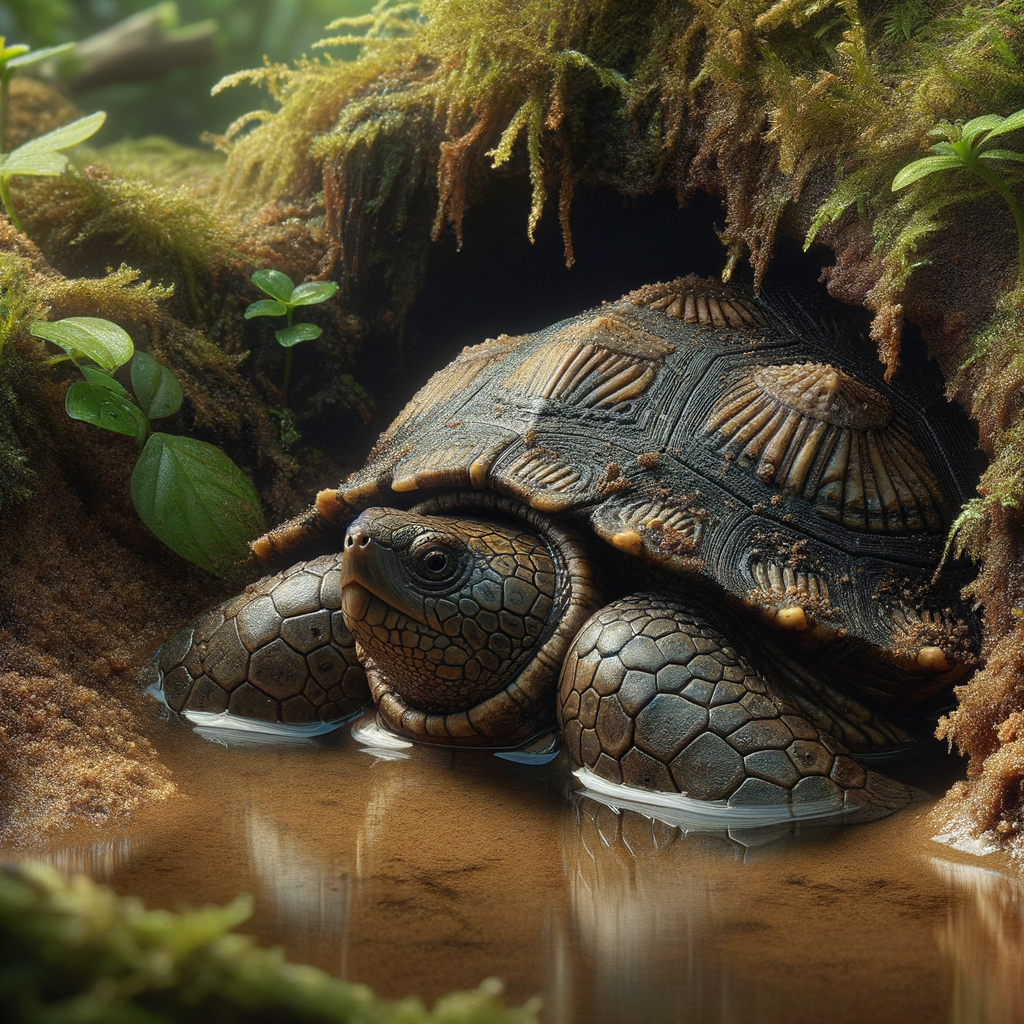
Introduction to the Spiny Softshell Turtle
Spiny Softshell Turtles are fascinating creatures that have captured the interest of many wildlife enthusiasts. In this section, we will explore an overview of the Spiny Softshell Turtle species and delve into their distinctive characteristics.
-
Overview of the Spiny Softshell Turtle Species
The Spiny Softshell Turtle, scientifically known as Apalone spinifera, is a unique species of turtle found predominantly in North America. They are known for their leathery shell, which is softer than the hard shells of most other turtle species. Spiny Softshell Turtles are semi-aquatic, meaning they spend a significant amount of their time both in and out of the water.
They are omnivorous and have a varied diet that includes insects, fish, and vegetation. The Spiny Softshell Turtle is one of the largest freshwater turtle species, with females growing up to 18 inches in shell length, while males are usually smaller, reaching up to 9.5 inches.
Scientific Name Shell Type Size Diet Apalone spinifera Softshell 9.5 – 18 inches Omnivorous -
Distinctive Characteristics of the Spiny Softshell Turtle
Spiny Softshell Turtles have several distinctive characteristics that set them apart from other turtle species. Their most notable feature is, of course, their soft, leathery shell, which is covered in small spines. These spines, along with the turtle’s sharp, pointed nose, give the Spiny Softshell Turtle its name.
Another unique trait of the Spiny Softshell Turtle is its ability to breathe through its skin. This allows them to stay underwater for extended periods, only surfacing occasionally for air. Their coloration, which ranges from olive to dark brown, helps them blend into their surroundings, providing excellent camouflage against potential predators.
The Spiny Softshell Turtle is also known for its speed, both in water and on land. They are agile swimmers and can move surprisingly fast on land, especially when they feel threatened.
The Rarity of Softshell Turtles
Softshell turtles are a unique group of turtles known for their leathery shells, hence the name ‘softshell’. However, these fascinating creatures are not as common as you might think. Let’s delve into why softshell turtles are considered rare and where they can be found globally.
- Why Softshell Turtles are Considered Rare
- Global Distribution of Softshell Turtles
Softshell turtles are considered rare for several reasons. Firstly, their unique habitat requirements limit their distribution. They prefer sandy or muddy bottoms in slow-moving or still waters, which are not as common as other types of habitats. Secondly, their nesting sites are also specific, requiring sandy banks where the female can lay her eggs. This makes it difficult for the species to expand their range.
Additionally, softshell turtles face numerous threats that contribute to their rarity. These include habitat destruction, pollution, and over-harvesting for food and the pet trade. As a result, many species of softshell turtles are now considered endangered or vulnerable.
Softshell turtles are found in various parts of the world, but their distribution is not widespread. They are primarily found in North America, Africa, and Asia. In North America, they are mostly found in the eastern and central parts of the United States and into Mexico. In Africa, they are found in the Nile River and its tributaries, while in Asia, they are found from India to China and Southeast Asia.
Despite their presence in these regions, their populations are often fragmented and isolated due to their specific habitat requirements and threats they face. This further contributes to their rarity and the challenges in their conservation.
In conclusion, the rarity of softshell turtles is a result of their unique habitat requirements, threats they face, and their fragmented distribution. It is crucial to protect these unique creatures and their habitats to ensure their survival and prevent their further decline.
Enigmatic Turtles: The Softshell Species
Softshell turtles are a fascinating group of reptiles, known for their unique characteristics and intriguing behaviors. In this section, we will delve into the world of these enigmatic creatures, focusing on their classification and distinctive features.
Understanding the Softshell Turtle Species
Softshell turtles belong to the family Trionychidae, which includes more than 25 different species. These turtles are found in various parts of the world, from North America to Africa and Asia. Despite their wide distribution, each species has its own unique features and adaptations that set it apart.
- Classification of Softshell Turtles
- Unique Features of Softshell Turtles
Softshell turtles are divided into two subfamilies: Trionychinae and Cyclanorbinae. The Trionychinae subfamily includes species like the spiny softshell turtle and the smooth softshell turtle, while the Cyclanorbinae subfamily includes species like the African softshell turtle and the Indian flapshell turtle. Each species is classified based on its physical characteristics, habitat, and behavior.
Softshell turtles are known for their distinctive soft, leathery shells, which lack the hard scutes found in other turtles. This feature gives them a streamlined shape, allowing them to swim faster in water. They also have long, flexible necks and snorkel-like noses, which they use to breathe while submerged. Additionally, softshell turtles are excellent burrowers, often burying themselves in sand or mud to hide from predators or to hunt for prey.
In conclusion, softshell turtles are a diverse and fascinating group of reptiles, each with its own unique adaptations and behaviors. By understanding their classification and unique features, we can appreciate the diversity and complexity of these enigmatic creatures.
Case Study: The Spiny Softshell Turtle
Let’s delve into a fascinating case study that highlights one of the most unique members of the softshell turtle family – the Spiny Softshell Turtle. We will explore its physical characteristics and behavioral traits.
- Physical Characteristics of the Spiny Softshell Turtle
- Behavioral Traits of the Spiny Softshell Turtle
The Spiny Softshell Turtle, scientifically known as Apalone spinifera, is a sight to behold. It is distinctively recognized by its flat, round body that resembles a pancake. The shell, which is soft and leathery, is predominantly olive or tan in color with dark spots. The males are smaller, measuring about 5 to 9.5 inches, while females can grow up to 7 to 18 inches.
One of the most striking features of this species is the elongated, pointy snout that aids in breathing when the turtle is submerged underwater. The feet are webbed for efficient swimming, and the edges of the shell are lined with small spines, hence the name ‘Spiny’ Softshell Turtle.
Spiny Softshell Turtles are known for their intriguing behavior. They are predominantly aquatic and spend most of their time buried in the soft sand or mud at the bottom of the water bodies, with only their heads poking out for breathing and surveillance. This behavior aids in their camouflage against predators.
They are excellent swimmers and can move swiftly when threatened. Interestingly, these turtles are also known to bask in the sun on sandy banks. They are omnivorous, feeding on a diet that includes insects, crustaceans, fish, and aquatic plants.
| Scientific Name | Apalone spinifera |
|---|---|
| Size | Males: 5-9.5 inches, Females: 7-18 inches |
| Distinctive Features | Flat, round body; soft, leathery shell; elongated, pointy snout; small spines on shell edges |
| Behavior | Predominantly aquatic, excellent swimmers, bask in the sun, omnivorous diet |
In conclusion, the Spiny Softshell Turtle is a unique and fascinating species. Its physical characteristics and behavioral traits set it apart in the turtle kingdom. Understanding these aspects can help us appreciate these creatures and contribute to their conservation.
Turtle Conservation: Focus on Endangered Turtles
In our journey of exploring the fascinating world of turtles, we now turn our attention to a critical aspect: turtle conservation. Specifically, we will focus on the endangered Spiny Softshell Turtle.
The Plight of the Spiny Softshell Turtle
The Spiny Softshell Turtle is a unique species that is currently facing a significant threat to its survival. This section will delve into the challenges this species faces and the efforts being made to conserve it.
- Threats to the Spiny Softshell Turtle Population
- Conservation Efforts for the Spiny Softshell Turtle
The Spiny Softshell Turtle faces numerous threats that have led to its endangered status. One of the major threats is habitat loss. As humans continue to develop and expand, the natural habitats of these turtles are being destroyed. Additionally, pollution, especially water pollution, poses a significant threat to these turtles. They are also often caught and sold in the illegal pet trade.
Despite the grim situation, there are ongoing efforts to conserve the Spiny Softshell Turtle. Many conservation organizations are working to protect and restore their habitats. They are also conducting research to better understand the needs of this species and how best to support them. Public education is another critical aspect of these conservation efforts, as raising awareness about the plight of these turtles can lead to greater protection measures and less harm to their habitats.
In conclusion, the Spiny Softshell Turtle is a unique and fascinating creature that is unfortunately facing significant threats. However, with ongoing conservation efforts and increased public awareness, there is hope for the future of this species.
Key Takeaways on Turtle Conservation
- The Importance of Turtle Conservation
- How Everyone Can Contribute to Turtle Conservation
- Reduce, Reuse, Recycle: By managing our waste, we can help reduce pollution, one of the major threats to turtles.
- Support Conservation Organizations: Donating to or volunteering with organizations dedicated to turtle conservation can make a significant impact.
- Educate Others: Spreading awareness about the importance of turtles and the threats they face can inspire others to take action.
Turtles, including the Spiny Softshell Turtle, play a vital role in our ecosystem. They help control pests by eating insects and dead animals, and their eggs provide food for other wildlife. Moreover, their nesting habits help aerate the soil, promoting plant growth. Unfortunately, their population is declining due to habitat loss, pollution, and illegal wildlife trade. The loss of these creatures could have a significant impact on our environment. Therefore, turtle conservation is essential to maintain the balance of our ecosystem.
Everyone can make a difference in turtle conservation. Here are some ways you can contribute:
Remember, every action counts. Together, we can ensure a future for these fascinating creatures.
Exploring the Softshell Turtle Habitat
Understanding the habitat of the softshell turtle is crucial to appreciating its unique lifestyle and survival tactics. Let’s delve into the typical habitats of these fascinating creatures.
Typical Habitats of Softshell Turtles
Softshell turtles are found in a variety of environments across the globe. Their adaptability to different habitats is one of their most impressive traits.
-
Geographical Distribution of Softshell Turtles
Softshell turtles are widely distributed across the globe. They are found in North America, Africa, and Asia. In North America, they inhabit the eastern and southern regions of the United States. In Africa, they are found in the Nile River and its tributaries. In Asia, they inhabit countries like China, India, and Indonesia. Their habitats range from freshwater bodies like rivers, streams, and lakes to brackish waters near coastal areas.
-
Adaptations of Softshell Turtles to Their Habitats
Softshell turtles have unique adaptations that help them survive in their respective habitats. Their flat, pancake-like bodies allow them to glide smoothly through the water, while their long necks and snouts enable them to breathe and hunt without fully surfacing. Their soft, leathery shells help them blend into the sandy or muddy bottoms of their habitats, providing excellent camouflage from predators.
These adaptations not only help softshell turtles survive but also make them a fascinating species to study. Their ability to thrive in diverse habitats across the globe is a testament to their resilience and adaptability.
Case Study: The Habitat of the Spiny Softshell Turtle
Let’s delve into a fascinating case study that explores the preferred habitats and unique adaptations of the Spiny Softshell Turtle.
- Preferred Habitats of the Spiny Softshell Turtle
- Adaptations of the Spiny Softshell Turtle to Its Habitat
The Spiny Softshell Turtle, scientifically known as Apalone spinifera, is a fascinating creature with a preference for specific habitats. These turtles are primarily found in North America, spanning from Canada to Mexico. They prefer freshwater habitats such as rivers, streams, and lakes with sandy or muddy bottoms. These habitats provide the turtles with ample space to swim and dive, as well as plenty of food sources like insects, fish, and crustaceans.
| Habitat Type | Examples |
|---|---|
| Freshwater Rivers | Mississippi River, Ohio River |
| Streams | Various small streams across North America |
| Lakes | Lake Erie, Lake Ontario |
Spiny Softshell Turtles have developed remarkable adaptations to thrive in their preferred habitats. Their soft, flat, and flexible shell, unlike the hard shell of most turtles, allows them to bury themselves in the sand or mud. This ability serves as an effective camouflage against predators and also helps them ambush prey.
Additionally, these turtles have a long, snorkel-like nose that enables them to breathe while submerged in water. Their webbed feet are perfect for swift swimming and digging in the soft bottoms of their habitats. These adaptations have made the Spiny Softshell Turtle a successful species in its chosen habitats.
In conclusion, the Spiny Softshell Turtle is a remarkable creature with a unique preference for freshwater habitats and fascinating adaptations to thrive in these environments. Understanding these aspects of their life can help us better protect and conserve these enigmatic creatures.
Decoding Softshell Turtle Behavior
Understanding the behavior of softshell turtles can be a fascinating journey. These unique creatures exhibit a range of behaviors that are both common to many turtles and unique to their species. Let’s delve into the world of softshell turtles and decode their behavior.
- Common Behaviors of Softshell Turtles
- Unique Behaviors of the Spiny Softshell Turtle
Softshell turtles, like other turtles, are known for certain common behaviors. These include basking in the sun to regulate their body temperature and burrowing into the sand or mud for protection or hibernation. They are also known for their swimming prowess. Unlike many other turtles, softshell turtles are excellent swimmers and spend a significant amount of time in the water.
The Spiny Softshell Turtle, a specific species of softshell turtles, exhibits some unique behaviors. One of the most distinctive is their ability to breathe through their skin. This allows them to stay underwater for extended periods, often up to several hours. Another unique behavior is their hunting strategy. Spiny Softshell Turtles are ambush predators. They bury themselves in the sand or mud with only their eyes and nostrils exposed, waiting for prey to come within striking distance.
These behaviors not only make softshell turtles fascinating creatures to observe but also highlight their adaptability to their environment. Whether it’s basking in the sun, burrowing into the sand, swimming skillfully, breathing through their skin, or using clever hunting strategies, softshell turtles are truly remarkable creatures.
| Behavior | Description |
|---|---|
| Basking | Regulates body temperature by absorbing heat from the sun. |
| Burrowing | Provides protection from predators and harsh weather conditions. |
| Swimming | Allows for efficient movement and hunting in aquatic environments. |
| Skin Breathing | Enables extended stays underwater by absorbing oxygen directly from the water. |
| Ambush Hunting | Increases hunting success by surprising unsuspecting prey. |
By understanding these behaviors, we can appreciate the complexity and adaptability of these amazing creatures. The world of softshell turtles is indeed a fascinating one, filled with intriguing behaviors and survival strategies.
Conclusion: The Fascinating World of Spiny Softshell Turtles
As we reach the end of our journey into the world of Spiny Softshell Turtles, let’s take a moment to reflect on what we’ve learned and why these unique creatures are so important to our ecosystem.
- Recap of the Spiny Softshell Turtle’s Characteristics
- The Importance of Protecting the Spiny Softshell Turtle
Spiny Softshell Turtles, known scientifically as Apalone spinifera, are truly unique creatures. They are easily identifiable by their flat, pancake-like bodies and their soft, leathery shells. Unlike most turtles, their shells are not hard, but rather soft and flexible. They have long, pointed snouts, which they use as a snorkel when they are submerged underwater. These turtles are also known for their speed, both in water and on land.
Spiny Softshell Turtles play a crucial role in maintaining the balance of our ecosystem. They help control the population of their prey, contributing to the overall health of the environment. However, these turtles are under threat due to habitat loss, pollution, and human interference. It is our responsibility to protect these fascinating creatures and their habitats for future generations.
Let’s remember that every creature, no matter how small or seemingly insignificant, has a role to play in our world. The Spiny Softshell Turtle is no exception. By understanding and appreciating these turtles, we can take steps to ensure their survival and the health of our planet.
| Characteristic | Description |
|---|---|
| Scientific Name | Apalone spinifera |
| Appearance | Flat, pancake-like body with a soft, leathery shell |
| Unique Feature | Long, pointed snout used as a snorkel |
| Speed | Fast, both in water and on land |
| Role in Ecosystem | Controls prey population, contributes to overall environmental health |
| Threats | Habitat loss, pollution, human interference |














